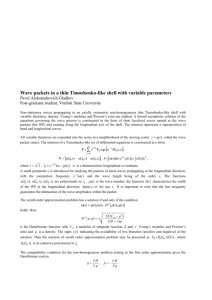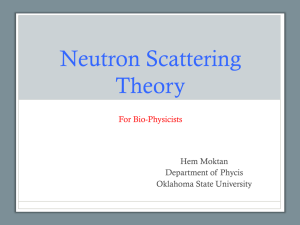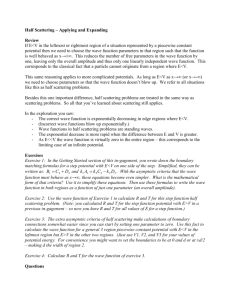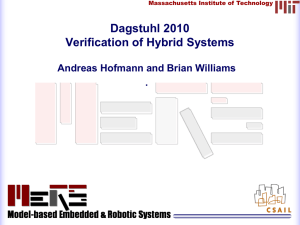Distributed computing on the ENEA Grid:
advertisement
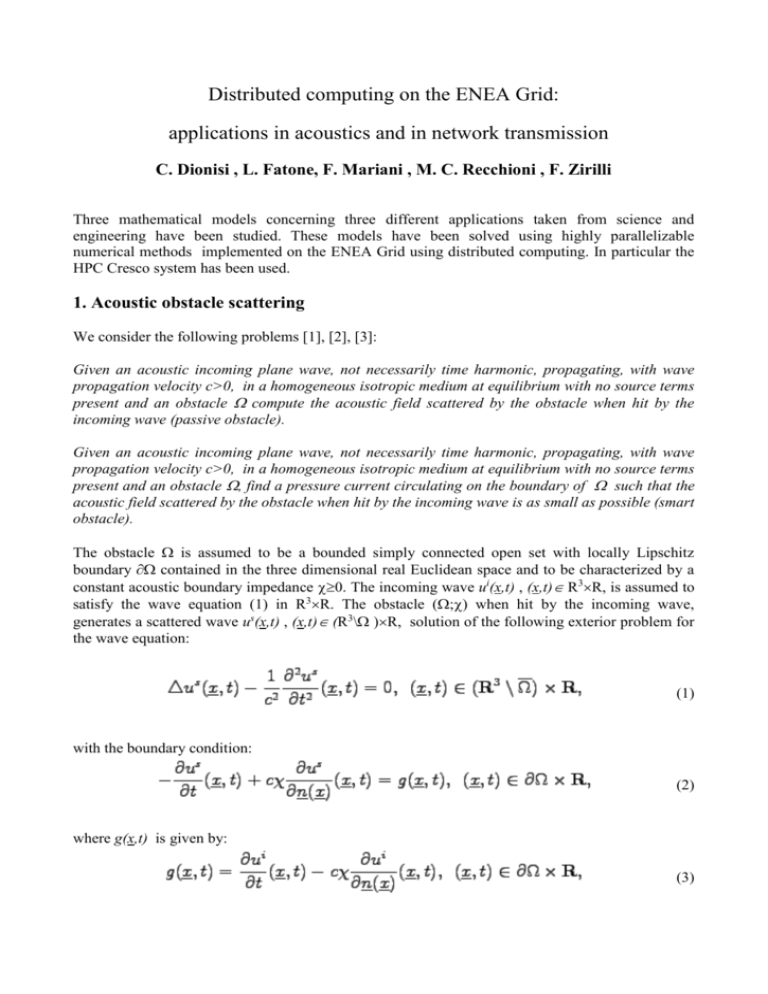
Distributed computing on the ENEA Grid:
applications in acoustics and in network transmission
C. Dionisi , L. Fatone, F. Mariani , M. C. Recchioni , F. Zirilli
Three mathematical models concerning three different applications taken from science and
engineering have been studied. These models have been solved using highly parallelizable
numerical methods implemented on the ENEA Grid using distributed computing. In particular the
HPC Cresco system has been used.
1. Acoustic obstacle scattering
We consider the following problems [1], [2], [3]:
Given an acoustic incoming plane wave, not necessarily time harmonic, propagating, with wave
propagation velocity c>0, in a homogeneous isotropic medium at equilibrium with no source terms
present and an obstacle compute the acoustic field scattered by the obstacle when hit by the
incoming wave (passive obstacle).
Given an acoustic incoming plane wave, not necessarily time harmonic, propagating, with wave
propagation velocity c>0, in a homogeneous isotropic medium at equilibrium with no source terms
present and an obstacle , find a pressure current circulating on the boundary of such that the
acoustic field scattered by the obstacle when hit by the incoming wave is as small as possible (smart
obstacle).
The obstacle is assumed to be a bounded simply connected open set with locally Lipschitz
boundary contained in the three dimensional real Euclidean space and to be characterized by a
constant acoustic boundary impedance 0. The incoming wave ui(x,t) , (x,t) R3R, is assumed to
satisfy the wave equation (1) in R3R. The obstacle (;) when hit by the incoming wave,
generates a scattered wave us(x,t) , (x,t) (R3\ )R, solution of the following exterior problem for
the wave equation:
(1)
with the boundary condition:
(2)
where g(x,t) is given by:
(3)
the boundary condition at infinity:
(4)
and the radiation condition:
(5)
where x=(x1,x2,x3)T R3, the superscript T means transposed, r=||x|| denotes the Euclidean norm
3
of the vector x,
2
is the Laplace operator, c>0 is the wave propagation velocity and
xi2
O(.) and o(.) are the Landau symbols. An obstacle (;) that when hit by the incoming wave ui
generates a scattered wave us solution of (1)-(5) is called passive obstacle. A passive obstacle is
transformed in a smart obstacle changing the boundary condition (3), that is adding to (3) a new
term representing the action of a suitable pressure current. The furtive obstacle scattering problem
stated above can be reformulated as an optimal control problem for the wave equation. Under
suitable assumptions, applying the Pontryagin maximum principle, the first order necessary
optimality condition relative to the optimal control problem considered can be derived [2]. This
necessary optimality condition is formulated as an exterior value problem for two coupled wave
equations. Assuming that the incoming and the scattered fields and some auxiliary variables can be
represented as superpositions of time harmonic waves, we reduce the solution of this exterior
problem to the solution of a set of exterior problems for two coupled Helmholtz equations.
i 1
The algorithm proposed to solve (1)-(5) and its generalization used to solve the scattering problem
for a smart obstacle is derived from a suitable reformulation of the “operator expansion method”
developed in [1]. Specifically when we consider problem (1)-(5), the algorithm proposed assumes
that the incoming wave and the scattered wave can be represented as a superposition of time
harmonic plane waves and reduces the solution of the time dependent problem for the wave
equation to the solution of a set of time harmonic scattering problems, that is to the solution of a set
of exterior boundary value problems for the Helmholtz equation, one problem for each frequency in
the spectrum of the incoming wave.
The solution of each exterior boundary value problem for the Helmholtz equation is approached
representing the solution a single layer potential with a density (that must be determined) defined
on the boundary of a suitable obstacle c contained in . The algorithm determines the densities
solving a set of integral equations defined on the boundaries of c and of a “reference” obstacle r.
The numerical difficulty of these exterior problems can be measured using the parameter RT defined
as the ratio between the characteristic dimension of the obstacle and the wavelength of the time
harmonic component of the acoustic incoming wave considered. The parameter RT is an adimensional quantity and large values of RT correspond to high frequency scattering, that is
correspond to numerically difficult problems.
In the numerical experiments presented in [1], [2], [3], the ratios RT considered range in the
interval [3,100]. This implies the use of high dimensional vector spaces to approximate
satisfactorily the integral equations corresponding to the exterior problems for the Helmholtz
equations. That is each integral equation after being discretized to be solved numerically becomes a
large system of linear equations. Represented on a generic base the matrices that approximate the
integral operators after the discretization will be dense matrices. The solution of large dense linear
systems adequate to discretize the scattering problems considered will become computationally
(computing time and memory requirements) unaffordable even for moderate values of RT. To avoid
this difficulty we represent the integral equations on a wavelet basis. After projecting on a finite
dimensional subspace generated by a truncated wavelet basis the resulting linear system of
equations can be approximated with a sparse linear system and can be solved solve numerically at
an affordable cost.
The resulting numerical method has been implemented on the ENEA Grid [3], [4] and is able to
deal with realistic acoustic scattering problems solving large (sparse) linear systems (up to
approximately
(real)) unknowns and equations.
These results shown in [1], [2], [3] are obtained using up to 1024 processors on the ENEA Grid.
The computation of the elements of the coefficient matrices of the linear systems considered and
several other aspects of the numerical algorithm proposed can be carried out as independent tasks
allowing the development of an efficient solver for exterior boundary value problems for the
Helmholtz equation, particularly well suited to be executed on a computing grid using distributed
computing. The solution of the resulting sparse linear systems is done using parallel computing on
the parallel machines present in the ENEA Grid.
Several numerical experiments involving a simplified version of the NASA space shuttle have been
performed (see [2], [3]). The reference surface r and the internal surface c have been
obtained manipulating the 3D model of the NASA space shuttle.
The HPC Cresco system has been widely used to compute the scattered field in high frequency and
to study the parallel performance of the algorithm on test problems. An example of the “parallel”
performance of the algorithm developed is shown in Table 1.
Number of processors
128
256
512
1024
Execution time (in seconds)
3941.26
2056.03
1035.16
536.52
Table 1: Execution time versus number of processors
Several animations and virtual reality applications concerning the numerical experiments discussed
here and in [3] are shown in the website www.econ.univpm.it/recchioni/scattering/w12/. A
more general reference to the work of some of the authors and of their coauthors in numerical
scattering is the website www.econ.univpm.it/recchioni/scattering.
2. Cascading blackouts in power transmission networks
In the last years the frequent and sometimes impressive electric current breaks registered around the
world made urgent the problem of understanding the behaviour of the high voltage power
transmission networks in critical conditions in order to characterize adequate operations to protect
their functions. Unfortunately the structural complexity of the real power transmission networks,
due to the high dependence between the components of the network, complicates the study of their
behaviour and is the main cause of their vulnerability. In fact, due to this interdependence, local
overloads of lines or local failures of components can generate cascades of (electric) current breaks
that, in extreme cases, can cause the fall of the whole network. We name this phenomenon:
``cascading blackout''.
The blackout can be caused by inefficiency of the power transmission network or by excessive
electric current demand from the loads that exceeds the network capacity. The cascading blackout is
a sequence of events characterized by line failures and/or load sheds.
We represent a power transmission network as an undirected graph, that is as a set of nodes
connected by branches (see [5], [6] for further details). The nodes can be classified in three
categories: generator nodes, representing wirings generating electricity, load nodes, constituting the
load of the network, and junction nodes. The branches connecting the nodes represent the network
transmission lines where the electric power flows. The lines have their own characteristic
admittance, small values of the admittance correspond to small power flow through the lines.
Let
be the number of nodes in the network considered and for k,m{1,2,…,N} let (k,m) be the
line connecting the node k to the node m, in order to describe the electric power flow in the network
the following quantities are considered:
yk,m=gk,m+ibk,m the admittance associated to the line (k,m), where i is the imaginary unit, gk,m
and bk,m are, respectively, the conductance and the susceptance of the line (k,m),
PkG the upper limit of the real power generated at the node k,
Pk=PkG + PkL the active power injected into the node k, where PkG and PkL are, respectively,
the real power generated and the real power demanded by the node k,
Fk,m the power flowing through the line (k,m),
Fk,m the upper power flow limit of the line (k,m),
PD=Nk=1 PkL the total load power demand,
PC=Nk=1 PkG the total network capacity,
Vk=|Vk|(cosk+sink) the complex voltage at node k.
Assuming assigned the network parameters mentioned above, in order to represent the power flow
through the network, we solve the DC (Direct Current) optimal power flow problem, that consists in
finding the vectors PG=(P1G, P2G,…, PNG) and the corresponding voltage angles =(1, 2,…, N)
that minimize the following cost function:
(6)
subject to the constraints:
(7)
| Fk ,m | Fk ,m,
0 PkG PkG ,
1 0,
k , m 1,2,..., N ,
(8)
where W is a real positive constant representing a cost associated to the load nodes (we choose
W=100). The optimal DC power flow model, describes the network behaviour in steady state
regime when the values of the parameters characterizing the model (the load power vector PL, the
generators and the lines capacities, the modulus of the generators voltages and the lines
admittances) are assigned.
Changes in the parameter values vary the network behaviour eventually causing blackouts. We
simulate the cascading blackout dynamics resulting as a consequence of variations of the total load
power demand PD assuming assigned the values of the remaining parameters.
As the total load power demand PD grows, the solution of the optimal DC power flow problem goes
through some changes. The blackout happens when the DC optimal power flow problem (6)-(8)
becomes unfeasible. In this case it is necessary to shed loads and/or to disconnect lines in the
attempt of restoring feasibility of the model and in this way a new problem is formulated. If the new
problem is also unfeasible, we continue to disconnect lines and/or to shed loads following some
simple rules specified in [5] and [6], until we find a feasible problem and finally we solve the
resulting feasible problem. This sequence of events simulates the blackout cascade and
mathematically corresponds to the formulation and the solution of a sequence of constrained
optimization DC problems. That is we simulate with a numerical scheme the sequence of events
that generates a cascading blackout.
The particular case of the Italian high voltage power transmission network has been studied and the
simulations needed to approximate the blackout size probability density function have been
obtained with a FORTRAN code running on the ENEA Grid. These simulations are run using
distributed computing, that is running clusters of hundreds of independent jobs on the grid.
The Italian high voltage power transmission network is represented as an undirected graph
constituted of N=310 nodes, with NG =97 generator nodes, NL =163 load nodes and NJ =30junction
nodes, and L=361 lines. Note that we consider junction nodes as load nodes with power load
smaller than
. In this network there are 14 lines that are double lines (i.e. there are two
lines joining the same two nodes). We substitute the double lines joining the corresponding nodes
with a single line whose admittance is given by the sum of the admittances of the lines constituting
the double line. Therefore the total number of lines in the network that we study is equal to M=36114=347. The website http://www.ceri.uniroma1.it/ceri/zirilli/w1 contains some auxiliary
material including animations that helps the understanding of the phenomena studied.
3. The traffic congestion phenomenon on complex networks
We study the congestion phenomenon for the traffic of data packets in transmission networks as a
function of the topology and of the network load . In particular analogies with the phase transition
phenomenon in statistical mechanics are studied. Two types of traffic are considered: homogeneous
traffic, that is the case when one kind of data packets is moving on the network, and
heterogeneous traffic, that is the case when more than one kind of data packets is moving on the
network. The heterogeneous traffic case studied consists in the flow on the network of three kinds
of data packets. We summarize only the results obtained in the heterogeneous traffic case. Similar
and somehow simpler results are obtained and presented in [7] for the homogeneous traffic case. A
capacity is associated to the branches (lines) of the network that is, the transmission network is
modelled as a weighted graph. The networks considered have complex topologies. The traffic
management rules are given. For traffic management rules we mean the set of rules that are used to
determine the traffic flow at the nodes where more than one data packet is waiting to be directed.
We devote our attention to transmission networks that have the small world property and to routing
strategies that assign different priorities to the different kinds of data packets. The behaviour of
these networks is compared to the behaviour of a simpler kind of networks called (modified) lattice
networks. The source node and the destination node of the data packets travelling on the network
are supposed to be distinct and are obtained sampling a random variable uniformly distributed on
the set of the couples of (distinct) nodes of the graph representing the network. A data packet
moves from a node to a node adjacent to the node where it is in a time unit. The number Mi of
packets of kind i generated in the network in a time unit is supposed to be described by a Poisson
random variable with mean i, i=1,2,3. Note that i=1,2,3, corresponds to the heterogeneous traffic
case considered (i.e.: there are three kinds of data packets travelling on the network), and that the
case of homogeneous traffic corresponds to i=1 (i.e.: there is only one kind of data packets
travelling on the network). For i=1,2,3, the mean load of kind i packets generated in the time unit, i
is chosen to be i= i, where is a real positive parameter, i 0 is a given constant and we
assume that 1 +2 +3 =1. The congestion phenomenon is studied in stationary conditions and is
recognized through the behaviour of two quantities related to the traffic properties. That is, for
i=1,2,3, the following quantities are considered: the mean travel time tMi of the data packets of
kind i and the mean number NLi of packets of kind i that have not reached their destination and are
travelling on the network. Note that when the traffic is not congested in stationary conditions for
i=1,2,3, we have that the quantities time tMi and NLi are independent of time and that they are
increasing functions of the network loads j, j=1,2,3. Given the network topology, the traffic
management rules and the constants j, j=1,2,3, the study of the quantities NLi and tMi, as a
function of , made through the use of numerical simulations shows that NLi and tMi have a jump
for a given value of , let us say =*i , i=1,2,3. Note that, when say >*i strictly speaking NLi
and tMi do not have a stationary value (in time) anymore and that in this case they diverge when
time increases, i=1,2,3. For i=1,2,3, the value *i is called critical value of the load for the traffic of
kind i data packets, and it divides (for the traffic of kind i data packets) the zone of congested traffic
(i= i> i*i) from the zone of free traffic (i= i< i*i) . Extensive traffic simulations (carried
out using a parallel MPI-code on HPC Cresco system [7]) on the networks considered are used to
study the behaviour of the critical values =*i, i=1,2,3, as a function of the topology and of the
load of the network. In particular we study the congestion phenomenon on two networks: Inet 3037
and a modified rectangular lattice. Inet 3037 is a network with 3037 nodes that is supposed to
reproduce the topological properties observed experimentally in Internet and is generated using the
software package Inet 3.0. Inet 3037 has the small world property. The modified rectangular lattice
that we consider is a simple modification of a rectangular lattice, has the same number of nodes
than Inet 3037 and does not have the small world property. Our analysis starts from the observation
that the complex networks, that is the networks having the small world property, and the lattice
networks behave very differently with respect to the congestion phenomenon. In fact let us
consider, for a moment, homogeneous traffic on networks where all the lines have the same
capacity it can be seen that a network having the small world property in the free traffic region is
much more efficient than a lattice network of similar “size” when, for example, we use the travel
time of data packets to measure efficiency. However when the network load increases a network
with the small world property reaches the congested regime for smaller values of the load than a
lattice network of similar “size”. When we consider heterogeneous traffic and networks with lines
of different capacities this fact becomes manifest in a more subtle way but it remains true. Having
this in mind we define a transformation depending on a parameter [0,1] that maps a network
having the small world property (=0) into a (modified) lattice network of similar “size” (=1)
having the same number of nodes. This map changes the weight of the branches of the graph having
the small world property to avoid the congestion of some branches. Using this transformation we
compare the behaviour of Inet 3037 (=0) to the behaviour of the modified rectangular lattice
(=1) mentioned above. Given the constants j, j=1,2,3, we study the critical values of the
parameter , that is the values *i, i=1,2,3, as a function of the parameter [0,1]. This study
suggests how to change the network topology in order to alleviate the congestion phenomenon [7].
Some analogies between the congestion phenomenon and the phase transition phenomenon studied
in statistical mechanics are studied.
References
[1] M. C. Recchioni and F. Zirilli, The use of wavelets in the operator expansion method for time
dependent acoustic obstacle scattering, SIAM J. Sci. Comput., 25, (2003), pp. 1158-1186.
[2] S. Migliori, G. Bracco, L. Fatone, M. C. Recchioni and F. Zirilli, A parallel code for time
dependent acoustic scattering involving passive or smart obstacles to appear in The International
Journal of High Performance Parallel Computing and Applications.
[3] L. Fatone, G. Rao, M. C. Recchioni, F. Zirilli, High performance algorithms based on a new
wavelet expansion for time dependent acoustic obstacle scattering, Communications in
Computational Physics, 2(6), (2007), pp. 1139-1173.
[4] S. Migliori, G. Bracco, C. Dionisi, F. Mariani, M. C. Recchioni, F. Zirilli, Parameter choice
models for two codes running on the ENEA grid , Report ENEA, 2007
[5] A. Farina, A. Graziano, F. Mariani, F. Zirilli, Probabilistic analysis of failures in power
transmission networks and ``phase transitions'': a study case of an high voltage power transmission
network, Journal of Optimization Theory and its Applications, 139(1), (2008), pp. 171-199.
[6] C. Dionisi, F. Mariani, M.C. Recchioni, F. Zirilli, Blackouts in power transmission networks
due to spatially localized load anomalies, to appear in Proceedings Critis’08, 3trd International
Workshop on Critical Information Infrastructures Security, Frascati, Roma, Italy, October 2008.
[7] A. Farina, A. Graziano, F. Mariani, M.C. Recchioni, F. Zirilli, Homogeneous and
heterogeneous traffic of data packets on complex networks: the traffic congestion phenomenon, in
preparation.


